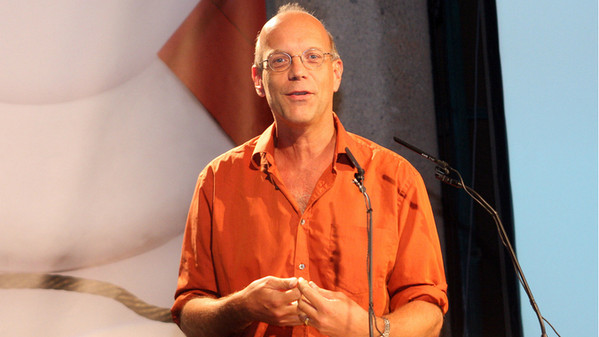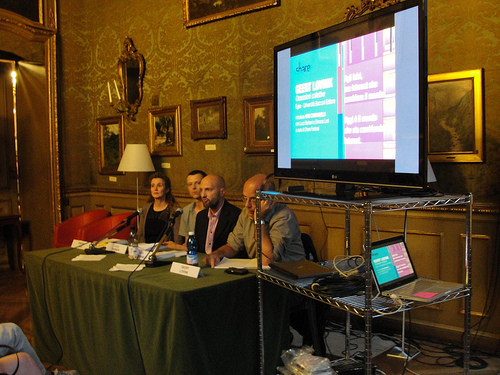
I recently had the pleasure of being part of a panel in Turin to present Networks Without a Cause, Geert Lovink's latest book on the social impact of social networks such as Facebook, Twitter, Flickr, LinkedIn, Google, and so on. For those of you not acquainted with Geert Lovink, he is one of the most brilliant and original theorists around today. He is also the founding director of the Dutch Institute of Network Cultures, whose mission is to explore, document and feed the potential for socio-technological change in the sphere of new media.

Lovink's book takes the specific question of what the social is in social media as its starting point, providing a sociological understanding of the dominant role that centralized media platforms play -- that is how they rule the Internet from the inside, and hence a good part of our daily lives. His insight revolves around the statement that "Once the Internet changed the world; now the world is changing the Internet."
This is a highly engaging book, packed thick with arguments. It would be impossible to give a detailed description of it all without writing an entire book in reply, because every word Lovink writes elicits a response in the reader. Hence, this review will focus on a more personal selection, on what struck me most, though my advice is to read it all from start to finish. Its strength lies in its thematic approach, touching on issues that may seem exhausted, such as the public versus the private sphere and privacy, but which, in Lovink's view, have yet to be overcome and which he addresses in depth in the book.

Above Geert Lovink
His analysis begins with the end of the computer and desktop age and the impact of mobile devices, which have heralded the end of the Internet as the social experience that it was originally created as and felt to be. Those who were part of that utopian era will remember the sense of freedom and the exciting awareness that something totally new was emerging. It was a hyper-stimulating time for creative types. A pioneering age for artists working with the Internet, comparable perhaps, in the way in which new media art developed and grew, with the underground film scene in New York in the 1960s and 70s. It was a time when everyone was doing everything, the early years of the net when everyone was an artist, programmer, curator, critic, and amateur in one, learning along the way and trying out new things, while not knowing where they would end up. It was an art scene abuzz with all the spontaneity that new media were providing.[1]
As that initial burst of early 1990s cyber culture faded away, new media continued to encounter and come up against organized society, in the form of corporations, governments, knowledge and educational institutions, and politics. All this was accompanied by an exponential increase in control, as Lovink points out, over the walled gardens of Google, Twitter and Facebook. Walled gardens 2.0 began to be developed specially in the wake of 9/11, as the Internet was targeted by government anti-terror propaganda, which painted a negative image of cyberspace as a lair of evil hackers, a channel for pornography and viruses, and a place where identity was susceptible to theft and required protection. And so the curtain was lifted on the Web 2.0, offering social spaces where personal information no longer needed protection because it was provided voluntarily, entrusted unto the hands of corporate henchmen who silently milk friends of friends of friends for all they are worth. Gilded cages that are a mint for those who manage them.

Above from right Simona Lodi, Luca Barbeni, Vito Campanelli, Geert Lovink in Turin for the presentation of the Italian version of the book.
Completely unaware, users of social networks have fallen into a trap laid by the politics of terror. Social networks are chains of complete strangers, who are not permitted to voice any true debate on any topic whatsoever. All that's allowed is a simple 'Like,' watering down any chance for critical exchange, doing even more than television to flatten out people's lives, and offering no tool that could have any real impact on everyday life, let alone political life.
Lovink stresses the point that social networks are socially useless as they lack a common cause. He looks at the total waste of time of using what he calls news industry tools -- media that enable real-time updates of no specific value, such as Twitter, which has created a constant flow of journalistic headlines without any depth of analysis or investigation, and which we no longer pay any attention to as we have become so blasé to it all.
What is clear is that, whether it is acknowledged or not -- and not all net theorists agree that the end of social networks is nigh -- we are in the midst of Internet bubble 2.0. There is no question that today social media dominate the use of the Internet and mobile devices, such as tablets and smartphones.
The book also shines a light on artistic responses that explore the relationship between politics and aesthetics. Centralized social networks may dominate the web, but Lovink also wants to give a voice to alternative, distributed networks, which is why he founded, together with Korinna Patelis, the work group Unlike Us, open to anyone who wants to take part. Click here to learn more.
This work group itself had become a network whose aim Lovink describes in the book as being to create a research network of artists, designers, scholars, activists and programmers who work on alternatives to corporate, and hence centralized, social media. He points to the propagation of the further development and proliferation of alternative, decentralized social networks -- the goal of Unlike Us -- but ultimately he falls into self-contradiction by seeking a decentralized alternative while at the same time heralding the death of the social network. Lovink's views on the development of digital media 2.0 suggest they are in decline or slowly dying off, as he himself explicitly states:
"...the forgettable Web 2.0 saga has run its course. The participatory crowds suddenly find themselves in a situation full of tension and conflict -- an unwelcome state of affairs for the pragmatist class who oversaw the internet's formation from the beginning. Criticism of Google and Facebook's privacy violations is on the rise. Conflicts over Net neutrality and WikiLeaks demonstrate that the friction-free days of 'multi-stakeholder' governance -- a loose coalition of corporations, NGOs, and engineers who kept state officials and old-school telecoms at bay, most notably through the World Summit on the Information Society (WSIS) -- are now over. A bubble has burst again, but this time in the form of the collapsing libertarian consensus model. Internet regulators who favored business and barred state intervention are moving into defense mode. Now that society has overruled their freewheeling ethic, the notion of the internet as an exceptional, unregulated sphere evaporates. The moment of decision bears upon us: which side are you on?" [2]
The most novel chapters of the book are in the first part and the in the last section focused on various examples of artistic responses, such as Video Vortex and online activism, whereas the central chapters are a reworking of issues addressed in previous works, such as My First Recession: Critical Internet Culture in Transition and Uncanny Networks: Dialogues With the Virtual Intelligentsia. Though he never takes up an extremist stance, along the lines of researcher Jodi Dean, nor an apocalyptic or integrated position, his approach is vastly different to that of other scholars, such as Henry Jenkins.
An optimist par excellence, Jenkins claims that digital infrastructure has a key role to play not only in supporting the public sphere, but in reinforcing the value of arenas for civic engagement (from bars to bowling alleys), but it is a belief that lacks critical vision. Limiting his observations largely to media presence, Jenkins explores circulation practices that expand civic space and create strong new links between various different social groups and spheres, taking the approach of a liberal consumer optimist.
But the world has changed and the time has come for networks with a cause.
Which is yours?
*************
Endnotes
[1] These thoughts of mine were shaped by an e-mail conversation with Patrick Lichty about the film "Blank City" by Celine Danhier and the new media art scene in the early 1990s (July 02-05, 2012).
[2] Geert Lovink, Networks Without a Cause. A Critique of Social Media, Cambridge: Polity Press, 2011; p 1